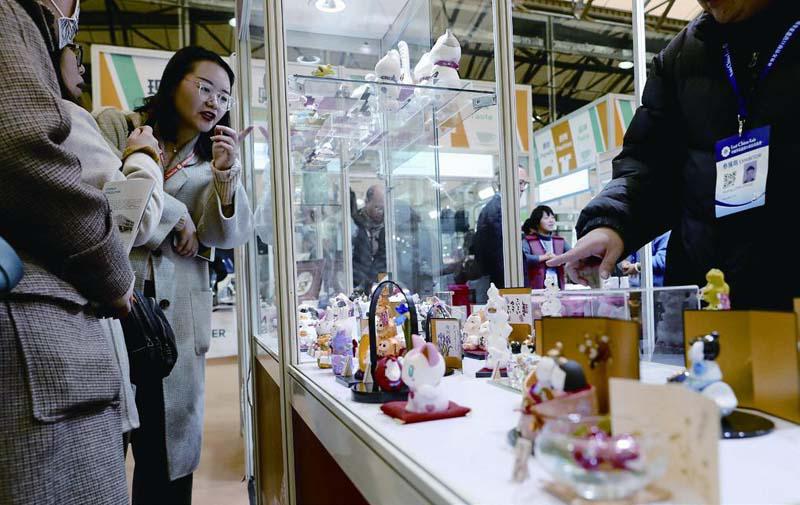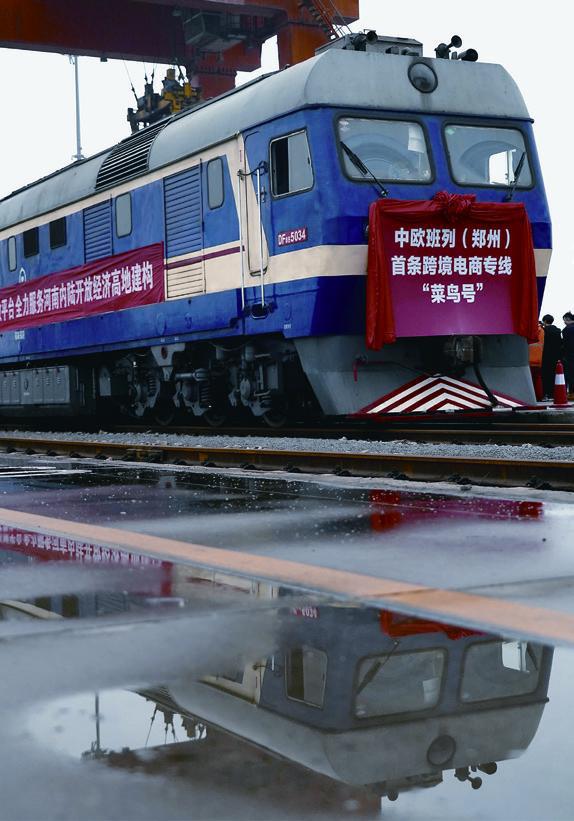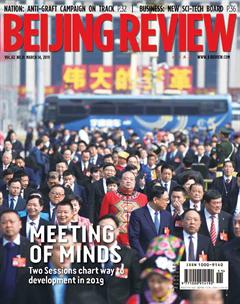High Five

A fi rst-grade student gives their teacher a high fi ve at the start of a new semester in Xining, northwest Chinas Qinghai Province, on March 1.
Technology Copyright
More than 1.1 million registrations for computer software copyrights were made in China in 2018, a yearon-year growth of 48.22 percent, according to a newspaper report on March 6.
Statistics from the National Copyright Administration show registrations for copyrights of apps saw a year-on-year increase of 76.29 percent last year.
The year-on-year growth for registrations regarding AI software and big data-related software reached 104.02 percent and 64.27 percent, respectively.
Regions which saw the most software copyright registrations included Guangdong Province, Beijing, Shanghai, and Jiangsu Province.
The number of registrations in Guangdong accounted for over 24 percent of the countrys total, the report said.
School Food Safety
The Ministry of Education announced on March 4 that it will launch a nationwide inspection of food safety standards at schools for the new spring semester.
The incidence of food poisoning is relatively high in spring, said the circular jointly issued by the general offi ces of the ministry and the State Administration for Market Regulation.
Local education departments and market watchdogs were ordered to screen loopholes in food safety control at schools and ensure a notable reduction in incidents of food poisoning.
It demanded schools conduct an internal inspection in areas of food safety management, sanitation, food facilities, and raw ingredients as well as health conditions and practices of people who have direct access to the schools food.
Local authorities should conduct spot checks of suppliers and grocery providers used by the school, it said.
The ministry also encouraged schools to accept supervision from parents and third parties and make public the process of food procurement via the Internet or other channels.
Water Efficiency
China saw improving effi ciency in water consumption last year, as it called for intensive and sustainable development.
In 2018, Chinas water consumption per 10,000 yuan ($1,491) of the gross domestic product dropped 5.1 percent compared to a year earlier to 73 cubic meters, according to the National Bureau of Statistics.
Last year, the amount of water consumed for 10,000 yuan of industrial value saw a decline of 5.2 percent year on year to 45 cubic meters.
Total water consumption in 2018 came in at 611 billion cubic meters, up 1.1 percent.
Water used for ecological restoration and everyday life rose 3.8 percent and 1.4 percent, while that for agriculture and industry rose 1.1 percent and 0.6 percent, respectively.
Lawyers Boost
China will train more lawyers to handle foreign-related matters, the Ministry of Justice said on February 28.
Xiong Xuanguo, Vice Justice Minister, said the move is aimed at safeguarding the legitimate rights and interests of Chinese institutions and nationals abroad.
“The task of safeguarding state economic security and development interests and strengthening the protection of rights and interests of Chinese businesses and citizens has become increasingly onerous as China continuously pushes forward its opening up and further implements national strategies such as the Belt and Road Initiative,” Xiong said.
He said the ministry will support Chinese lawyers to play a bigger role in the countrys major foreignrelated economic and trade activities and increase their international competitiveness.
Social Credit System
China will improve its social credit system to promote honesty and deter deceitful behavior, a spokesperson with the annual session of the countrys top political advisory body said on March 2.
More than 17 million f lights and f vie million train journeys were denied to poor credit performers between October 2013 and December 2018, Guo Weimin, spokesperson for the Second Session of the 13th National Committee of the Chinese Peoples Political Consultative Conference, said at a press conference.
China has accelerated the expansion of a social credit system since the State Council fi rst issued guidelines in 2014. A national credit information online platform is now in place, where honest people and enterprises are honored, while poor credit performers like defaulting debtors and taxpayers are blacklisted with measures such as restrictions on enjoying certain services.
The development of a sound social credit system is a long-term and complicated systematic project that entails joint efforts. China will enhance education and improve related mechanisms to achieve this end, Guo added.
Cultural Protection
A regulation on the management of“state reserves of cultural ecology”came into force on March 1.
The regulation clarifi es procedures for the establishment, evaluation, fi ling and licensing of such reserves.
It also demands checks and evaluations on the operation and building of such reserves. Well-built cases will be praised and supported, and those failing to protect cultural ecology from damage will face severe punishment and lose their licenses.
The protection of state reserves of cultural ecology focuses on unique and long-lasting regional cultural systems, in particular, intangible cultural heritage, according to the regulation.
Since 2007, a total of 21 reserves have been founded during the trial run of the project.
Taking Care of Ears
A medical volunteer performs an ear canal test on a senior citizen during a charity event held in Beijing on March 3, Chinas National Ear Care Day.
Fishing Ban
The four-month fi shing ban, aiming to protect aquatic resources and biodiversity in Chinas rivers, started on March 1.
The annual ban, which lasts from March 1 to June 30, covers the main streams, tributaries, and lakes along major rivers including the Yangtze, the Pearl and the Minjiang.
The Department of Agriculture and Rural Affairs of east Chinas Jiangsu Province, working with relevant departments, launched a series of enforcement actions on March 1.
Around 30 vessels will inspect Jiangsus main streams for at least 10 days.
Zhang Jianjun, Deputy DirectorGeneral of the provincial agriculture and rural affairs department, said that over 60,000 meters of illegal netting have been cleared, and 405 people violating fi shing regulations have been penalized over the past three years.
Ni Zhimin, a fi sherman in Hangzhou, the capital of east Chinas Zhejiang Province, sells the fresh fi sh he catches in the Qiantang River every day. Ni fi shed for the last time on February 28 and must now wait for four months until the ban is over.
The Qiantang is the largest river in Zhejiang and is known for having the worlds largest tidal bore. It is home to over 85 percent of the freshwater fi sh species in the province.
However, fi sh species in the river declined from 149 in the 1970s to 122 in 2019.
From March 1, the entire basin of the Qiantang has imposed the fi shing ban for the fi rst time. During this period, all forms of fi shing activities are banned, except recreational fi shing.
The agricultural department and procuratorates in southeast Chinas Fujian Province launched a series of fi shing ban promotional activities in fi shing villages across the province earlier on February 22.
The provincial department of ocean and f siheries said a f sihing ban has been imposed on the Minjiang, a major river in Fujian. Fishing activities for research purposes must be approved by local f sihery departments.
An Eyeful of Goodies
Visitors view exhibits at a Japanese booth during the 29th East China Fair in Shanghai on March 1, the fi rst day of the fair.
Platform Economy
China will facilitate the development of the platform economy by fostering a batch of 100-billion-yuan($15-billion) commodity markets by 2020.
Through the development of the platform economy, China aims to build a commodity circulation system that fi ts the modern economic system, said a guideline jointly released by the Ministry of Commerce and 11 other departments.
The platform economy is economic and social activity facilitated by platforms, which are typically online matchmakers or technology frameworks.
The development of the platform economy will benefi t the upgrading of industry and consump- tion, serve supply-side structural reform and promote the establishment of a strong domestic market, according to the guideline.
It also specifi ed requirements for the development of the platform economy, including encouraging commodity markets to adapt to the demand of the digital economy and promoting the connectivity of commodity markets with different sectors and regions.
Preferential policies in land and fi nancing will be released to consolidate commodity markets for the development of the platform economy, the guideline said.
Midnight Operation
A signalman tests the circuit in Zhifang No.1 Tunnel in Xian, capital of northwest Chinas Shaanxi Province, on February 28. The Xian-Chengdu High-Speed Railway is Chinas fi rst rail route running through the Qinling Mountains, the natural north-south boundary of the country. Maintenance is conducted only at night or early in the morning when all trains stop services.
Higher Weight
Capital infl ow into the Chinese onshore stock market will acceler- ate in 2019 thanks to global index supplier MSCIs decision to hike the inclusion factor of Chinas A-Shares from 5 percent to 20 percent in three steps within the year, according to a research note by Swiss multinational investment bank UBS Group AG.
The weighting for Chinese A-shares in the MSCI Emerging Market Index will rise to 3.3 percent by November, up from 0.7 percent at present, the MSCI said.
“This latest MSCI weight increase should help trigger at least $60 billion in infl ows to A-shares in 2019, pushing cumulative foreign ownership above $160 billion,” said the research note issued on March 1.
Higher A-share allocation is a long-term structural trend for international investors, it added.
Incremental buying in the short term will probably remain biased toward select sectors and stocks currently preferred by overseas capital, such as white goods, insurance, healthcare and electronics, it said.
Meanwhile, the sharp run-up in onshore brokers, partially stoked by recent recovery in onshore stock markets, offers attractive levels to take profi ts in the sector, according to UBS.
MSCIs announcement of a higher A-share inclusion factor will bring a new pool of international investors to the A-share market, which overtime will help raise transparency and improve governance for these listed companies, said Jorge Mariscal, chief investment offi cer on emerging markets with UBS Wealth Management.
Structural Reform
Solid progress was made in the structural reform of Chinas economy in 2018, with traditional sectors becoming more effi cient and new growth drivers stronger, an offi cial report said on February 28.
The National Bureau of Statistics published a communiqué on the economic and social development in 2018, noting that supply-side structural reform deepened.
Thanks to efforts to downsize glutted sectors, the national industrial capacity utilization ratio remained at a relatively high level of 76.5 percent. The ratio for coal mining and washing sectors rose 2.4 percentage points from 2017 to 70.6 percent.
Chinas housing inventory was down signifi cantly, and the debt-toasset ratio for industrial businesses also dropped. Corporate operation costs declined as governments moved to reduce the burden on business, and investment surged in weak areas including environmental protection and agriculture.
The communiqué also showed robust new economic engines as the output of strategically emerging industries went up 8.9 percent year on year and hi-tech manufacturing expanded 11.7 percent. Equipment manufacturing grew 8.1 percent and accounted for nearly a third of the total industrial output.
Hi-tech investment went up 14.9 percent, and investment in tech upgrading increased 12.8 percent.
Under the guidance of the highquality development concept, the economy posted stable performance in 2018 with improved quality and better livelihood for people, a step forward in building a moderately prosperous society in all respects, the communiqué said.
An Upgrading Process
Workers at an automobile company in Jingxian County, north Chinas Hebei Province, assemble a new-energy sweeper vehicle on February 28. The county has been encouraging local manufacturing enterprises to strengthen research and development of tech-intensive products.
Wealth Management
Chinas wealth management products have become an important investor in the countrys fi nancial market, according to a statement on the website of the China Banking and Insurance Regulatory Commission(CBIRC).
Issuance of such products has grown rapidly in recent years. At the end of 2018, the balance of bank wealth management products stood at 32 trillion yuan ($4.7 trillion), up 2.5 trillion yuan ($372.8 billion), or 8.5 percent, from a year earlier.
Almost 70 percent of the funds raised through wealth management products are invested in bonds, deposits and money market instruments.
The strong growth in such products in recent years has been supported by the higher yield they offer investors compared with the regulated ceilings on deposit rates and a desire among banks to obtain more funding.
The country will guide the funds raised through wealth management products to invest in the fi nancial market in a lawful way, in a bid to promote the development of direct fi nancing and improve the countrys fi nancial system, said Li Wenhong, an offi cial with the CBIRC.
ICBC Loans
The Industrial and Commercial Bank of China (ICBC), Chinas largest lender by market value, has extended trillions of yuan of loans to the countrys manufacturing sector in the past few years.
As of the end of 2018, outstanding loans from the ICBC to the manufacturing industry amounted to 1.38 trillion yuan ($206 billion), among which over 500 billion yuan($74.6 billion) went to the advanced manufacturing sector.
The ICBC offered various fi nancing services, including equity fi nancing, industry funds and debt restructuring, to address manufacturers multiple needs and lower their costs, according to ICBC sources.
The bank participated in fi nancing projects in fi elds such as advanced technology, petrochemical engineering and shipbuilding.
It also provided fi nancing support for Chinese brands international business and helped the countrys advanced manufacturers to promote international cooperation and improve their competitiveness worldwide.
E-Commerce Route
A freight train prepares for its maiden trip from Zhengzhou, central Chinas Henan Province to Liege, Belgium, on March 2. The new route, which is exclusively for cross-border e-commerce, is part of the China-Europe freight train service under the Chinaproposed Belt and Road Initiative.
Innovation Festival
More than 1,000 entrepreneurs, investors and tech professionals from China and the United States will convene in May in Silicon Valley to explore possible areas of collaboration, an organizer said on March 1. The Silicon Valley Entrepreneurs Festival, which was launched in 2016, is scheduled for May 2 at the Santa Clara Convention Center, about 72 km southeast of San Francisco, California.
The event will be organized by Ding Ding TV, a local Internet TV station, and the China-U.S. Business Summit, in partnership with Santa Clara Chamber of Commerce.
This years conference will highlight digital transformation opportunities in artifi cial intelligence, with big data, the Internet of Things, digital marketing trends, content evolution and venture capital the areas of focus, said CEO of the festival and founder of Ding Ding TV Diana Ding at a press conference in Santa Clara.
“This years festival will welcome world-leading investors and entrepreneurs from the United States and Asia and showcase innovative ideas and breakthroughs in investment and entrepreneurship,” said Mayor of Santa Clara Lisa Gillmor at the press conference.
“Its going to bring together economists, investors and innovators to talk about the future of technology,” said Gillmor. “Last year, the festival attracted about 1,800 individuals. This year, we expect more.”

